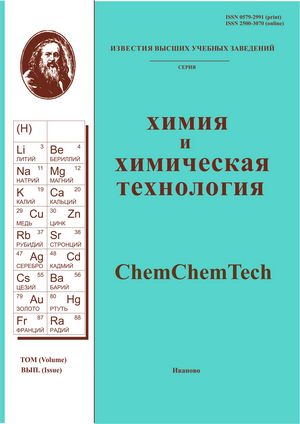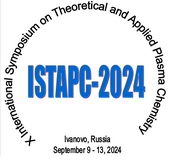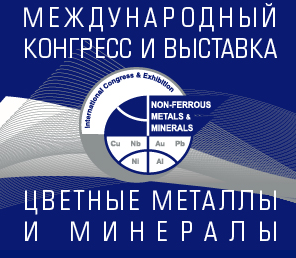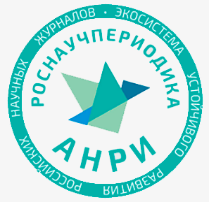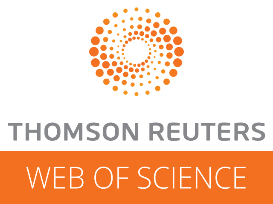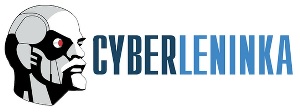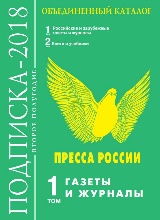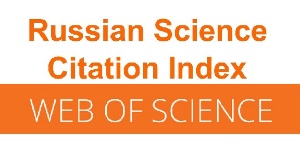ОЧИСТКА И ОБЕЗЗАРАЖИВАНИЕ ВОДЫ УФ ИЗЛУЧЕНИЕМ СВЕТОДИОДНОЙ МАТРИЦЫ (365 НМ) В ЖЕЛЕЗО-ПЕРСУЛЬФАТНОЙ СИСТЕМЕ
Аннотация
В данном исследовании изучены кинетические закономерности и определены дозы УФ излучения для одновременной деструкции гербицида атразина и инактивации бактерий Escherichia coli и Enterococcus faecalis в железо-персульфатной окислительной системе {УФ/ПС/Fe2+} с применением УФ-А светодиодной матрицы (365 нм). Установлено, что данная система является наиболее эффективной для деструкции атразина и инактивации E. faecalis в ряду: {УФ/ПС/Fe2+} > {УФ/ПС} > {ПС/Fe2+} > {УФ}. Эффективность инактивации E. coli в системах {УФ/ПС/Fe2+} и {УФ/ПС} была одинаковой, что вызвано преобладающим вкладом высокоинтенсивного УФ излучения, к воздействию которого кишечная палочка менее устойчива, чем энтерококки. Доза УФ излучения для деструкции 90% атразина в отсутствии бактерий в железо-персульфатной системе составила 0,48 Дж/см2, тогда как для инактивации 100% клеток E. coli и E. faecalis без атразина – 0,94 и 1,43 Дж/см2, соответственно. Внесение бактерий в раствор вызвало ингибирование деструкции атразина и снижение соответствующих констант скорости (и увеличение доз излучения) на один порядок. Ингибирование инактивации бактерий в присутствии гербицида было более выражено для энтерококков. При этом, для разложения атразина требовались значительно более высокие УФ дозы (7,7 Дж/см2), чем для полной инактивации E. coli (1,0 Дж/см2) и E. faecalis (2,1 Дж/см2), что обеспечивало одновременное обеззараживание воды. Полученные результаты свидетельствуют о принципиальной возможности и энергоэффективности одноэтапной очистки и обеззараживания воды в железо-персульфатной системе, активированной излучением УФ-А светодиодной матрицы.
Литература
Zhong H., Li J., Zhao H., Sun L., Xu A., Xia D., Nevsky A.V. Degradation of acid orange 7 in aqueous solution under presence of iron (Ш), persulphate and visible light irradiation. ChemChemTech [Izv. Vyssh. Uchebn. Zaved. Khim. Khim. Tekhnol.]. 2017. V. 60. N 3. P. 48−54 (in Russian). DOI: 10.6060/tcct.2017604.5545.
Popova S.A., Matafonova G.G., Batoev V.B. Sonophoto-chemical oxidation of organic contaminants in aqueous solutions using persulfate. ChemChemTech [Izv. Vyssh. Uchebn. Zaved. Khim. Khim. Tekhnol.]. 2020. V. 63. N 10. P. 105-109. DOI: 10.6060/ivkkt.20206310.6233.
Xiao R., Liu K., Bai L. Inactivation of pathogenic microorganisms by sulfate radical: Present and future. Chem. Eng. J. 2019. V. 371. P. 222–232. DOI: 10.1016/j.cej.2019.03.296.
Fiorentino A., Esteban B., Garrido-Cardenas J.A. Effect of solar photo-Fenton process in raceway pond reactors at neutral pH on antibiotic resistance determinants in secondary treated urban wastewater. J. Hazard. Mater. 2019. V. 378. P. 120737. DOI: 10.1016/j.jhazmat.2019.06.014.
de la Obra Jiménez I., Giannakis S., Grandjean D. Unfolding the action mode of light and homogeneous vs. heterogeneous photo-Fenton in bacteria disinfection and concurrent elimination of micropollutants in urban wastewater, mediated by iron oxides in Raceway Pond Reactors. Appl. Catal. B. 2020. V. 263. P. 118158. DOI: 10.1016/j.apcatb.2019.118158.
López-Vinent N., Cruz-Alcalde A., Malvestiti J.A. Organic fertilizer as a chelating agent in photo-Fenton at neutral pH with LEDs for agricultural wastewater reuse: Micropollutant abatement and bacterial inactivation. Chem. Eng. J. 2020. V. 388. P. 124246. DOI: 10.1016/j.cej.2020.124246.
Marjanovic M., Giannakis S., Grandjean D. Effect of μM Fe addition, mild heat and solar UV on sulfate radical-mediated inactivation of bacteria, viruses, and micropollutant degradation in water. Water Res. 2018. V.140. P. 220–231. DOI: 10.1016/j.watres.2018.04.054.
Rodríguez-Chueca J., Giannakis S., Marjanovic M. Solarassisted bacterial disinfection and removal of contaminants of emerging concern by Fe2+-activated HSO5- vs. S2O82- in drinking water. Appl. Catal. B. 2019. V. 248. P. 62–72. DOI: 10.1016/j.apcatb.2019.02.018.
Rodríguez-Chueca J., García-Cañibano C., Lepistö R.-J. Intensification of UV-C tertiary treatment: Disinfection and removal of micropollutants by sulfate radical based Advanced Oxidation Processes. J. Hazard. Mater. 2019. V. 372. P. 94–102. DOI: 10.1016/j.jhazmat.2018.04.044.
Popova S., Matafonova G., Batoev V. Simultaneous atrazine degradation and E. coli inactivation by UV/S2O82-/Fe2+ process under KrCl excilamp (222 nm) irradiation. Ecotoxi-col. Environ. Saf. 2019. V. 169. P. 169–177. DOI: 10.1016/j.ecoenv.2018.11.014.
Egorov N.S. A guide to practical exercises in microbiology. M.: MGU. 1995. P. 122–125.
Bolton J.R., Cotton C.A. The Ultraviolet Disinfection Handbook. Denver, CO: AWWA. 2008. 150 p.
Jin S., Mofidi A.A., Linden K.G. Polychromatic UV fluence measurement using chemical actinometry, biodosimetry, and mathematical techniques. J. Environ. Eng. 2006. V. 132. P. 831–841. DOI: 10.1061/(ASCE)0733-9372(2006)132:8(831).
Kheyrandish A., Taghipour F., Mohseni M. UV-LED radiation modeling and its applications in UV dose determination for water treatment. J. Photochem. Photobiol. A: Chem. 2018. V. 352. P. 113–121. DOI: 10.1016/j.jphotochem.2017.10.047.
Keshavarzfathy M., Malayeri A.H., Mohseni M., Taghipour F. UV-LED fluence determination by numerical method for microbial inactivation studies. J. Photochem. Photobiol. A. 2020. V. 392. P. 112406. DOI: 10.1016/j.jphotochem.2020.112406.
Bolton J.R., Stefan M.I., Shaw P., Lykke K.R. Determination of the quantum yields of the potassium ferrioxalate and potassium iodide–iodate actinometers and a method for the calibration of radiometer detectors. J. Photochem. Photo-biol. A. 2011. V. 222. P. 166–169. DOI: 10.1016/j.jphotochem.2011.05.017.
Goldstein S., Rabani J. The ferrioxalate and iodide-iodate actinometers in the UV region. J. Photochem. Photobiol. A. 2008. V. 193. P. 50–55. DOI: 10.1016/j. jphotochem.2007.06.006.
Beck S.E., Ryu H., Boczek L.A. Evaluating UV-C LED disinfection performance and investigating potential dual-wavelength synergy. Water Res. 2017. V. 109. P. 207–216. DOI: 10.1016 / j.watres.2016.11.024.
Manoj P., Prasanthkumar K.P., Manoj V.M., Aravind U.K., Manojkumar T.K., Aravindakumar C.T. Oxidation of substituted triazines by sulfate radical anion (SO4●-) in aqueous medium: A laser flash photolysis and steady state radiolysis study. J. Phys. Org. Chem. 2007. V. 20. P. 122-129. DOI: 10.1002/poc.1134.
Garkusheva N., Matafonova G., Tsenter I. Simultaneous atrazine degradation and E. coli inactivation by simulated solar photo-Fentonlike process using persulfate. J. Environ. Sci. Health A. 2017. V. 52. P. 849–855. DOI: 10.1080/10934529.2017.1312188.
Moncayo-Lasso A., Mora-Arismendi L.E., Rengifo-Herrera J.A. The detrimental influence of bacteria (E. coli, Shigella and Salmonella) on the degradation of organic compounds (and vice versa) in TiO2 photocatalysis and nearneutral photo-Fenton processes under simulated solar light. Photochem. Photobiol. Sci. 2012. V. 11. P. 821–827. DOI: 10.1039/c2pp05290c.
Timchak E., Timchak E., Gitis V. A combined degradation of dyes and inactivation of viruses by UV and UV/H2O2. Chem. Eng. J. 2012. V. 192. P. 164–170. DOI: 10.1016/j.cej.2012.03.054.
Barrera M., Mehrab M., Gilbride K.A. Photolytic treatment of organic constituents and bacterial pathogens in secondary effluent of synthetic slaughterhouse wastewater. Chem. Eng. Res. Des. 2012. V. 90. P. 1335–1350. DOI: 10.1016/j.cherd.2011.11.018.
Subramanian G., Parakh P., Prakash H. Photodegradation of methyl orange and photoinactivation of bacteria by visible light activation of persulfate using a tris (2,2’-bipyridyl)ruthenium (II) complex. Photochem. Photobiol. Sci. 2013. V. 12. P. 456–466. DOI: 10.1039/c2pp25316j.
He J., Zeng X., Lan S., Lo I.M.C. Reusable magnetic Ag/Fe, N-TiO2/Fe3O4@SiO2 composite for simultaneous photocatalytic disinfection of E. coli and degradation of bisphenol A in sewage under visible light. Chemosphere. 2019. V. 217. P. 869–878. DOI: 10.1016/j.chemosphere.2018.11.072.
Zhou S., Li L., Wu Y., Zhu S., Zhu N., Bu L. UV365 induced elimination of contaminants of emerging concern in the presence of residual nitrite: roles of reactive nitrogen species. Water Res. 2020. V. 178. P. 115829. DOI: 10.1016/j.watres.2020.115829.
Li B., Ma X., Li W, Chen Q., Deng J., Li G. Factor affecting the role of radicals contribution at different wavelengths, degradation pathways and toxicity during UV-LED/chlorine process. Chem. Eng. J. 2020. V. 392. P. 124552. DOI: 10.1016/j.cej.2020.124552.
Stanley J., Patras A., Pendyala B., Vergne M.J., Bansode R.R. Performance of a UV-A LED system for degradation of aflatoxins B1 and M1 in pure water: kinetics and cytotoxicity study. Sci. Rep. 2020. V. 10. P. 13473. DOI: 10.1038/s41598-020-70370-x.
Ferreira L.C., Fernandes J.R., Rodríguez-Chueca J., Peres J.A., Lucas M.S., Tavares P.B. Photocatalytic degra-dation of an agroindustrial wastewater model compound us-ing a UV LEDs system: kinetic study. J. Environ. Manag. 2020. V. 269. P. 110740. DOI: 10.1016/j.jenvman.2020.110740.
Tan C., Wu H., He H., Lu X., Gao H., Deng J., Chu W. Antiinflammatory drugs degradation during LED-UV365 photolysis of free chlorine: roles of reactive oxidative species and formation of disinfection byproducts. Water Res. V. 185. P. 116252. DOI: 10.1016/j.watres.2020.116252.
de la Obra I., García E.B., García Sánchez J.L., Casas López J.L., Sánchez Pérez J.A. Low cost UVA-LED as a radiation source for the photo-Fenton process: a new approach for micropollutant removal from urban wastewater. Photochem. Photobiol. Sci. 2017. V. 16. P. 72–8. DOI: 10.1039/C6PP00245E.
Malkhasian A., Izadifard M., Achari G., Langford C. Photocatalytic degradation of agricultural antibiotics using a UV-LED light source. J. Environ. Sci. Health B. 2014. V. 49. P. 35–40. DOI: 10.1080/03601234.2013.836871.
Serna-Galvis E.A., Troyon J.A., Giannakis S., Torres-Palma R.A., Carena L., Vione D. Kinetic modeling of lag times during photoinduced inactivation of E. coli in sunlit surface waters: unraveling the pathways of exogenous action. Water Res. 2019. 163. P. 114894. DOI: 10.1016/j.watres.2019.114894.
Schlegel G. General microbiology. M.: Mir. 1987. 567 p. (in Russian).
Methodical instructions. The use of ultraviolet radiation in the disinfection of swimming pool water. 1998. https://docs.cntd.ru/document/1200011524
Chen P.-Y., Chu X.-N., Liu L., Hu J.-Y. Effects of salinity and temperature on inactivation and repair potential of En-terococcus faecalis following medium- and low-pressure ultraviolet irradiation. J. Appl. Microbiol. 2016. V. 120. N 3. P. 816-825. DOI: 10.1111/jam.13026.
Mori M., Hamamoto A., Takahashi A., Nakano M., Wakikawa N., Tachibana S. Development of a new water sterilization device with a 365 nm UV-LED. Med. Biol. Eng. Comput. 2007. V. 45. P. 1237–1241. DOI: 10.1007/s11517-007-0263-1.
Hamamoto M., Mori A., Takahashi M., Nakano N., Wakikawa N., Akutagawa M. New water disinfection sys-tem using UVA lightemitting diodes. J. Appl. Microbiol. 2007. V. 103. P. 2291–2298. DOI: 10.1111/j.1365-2672.2007.03464.x.
Lui G.Y., Roser D., Corkish R., Ashbolt N.J., Stuetz R. Pointof-use water disinfection using ultraviolet and visible lightemitting diodes. Sci. Tot. Environ. 2016. V. 553. P. 626–635. DOI: 10.1016/j.scitotenv.2016.02.039.
Prasad A., Ganzle M., Roopesh M.S. Inactivation of Esch-erichia coli and Salmonella using 365 and 395 nm high intensity pulsed light emitting diodes. Foods. 2019. V. 8. P. 679. DOI: 10.3390/foods8120679.
Song K., Mohseni M., Taghipour F. Mechanisms investigation on bacterial inactivation through combinations of UV wavelengths. Water Res. 2019. V. 163. P. 114875. DOI: 10.1016/j.watres.2019.114875.
Xiong P., Hu J. Inactivation/reactivation of antibiotic-resistant bacteria by a novel UVA/LED/TiO2 system. Water Res. 2013. V. 47. P. 4547–4555. DOI: 10.1016/j.watres.2013.04.056.
Montenegro-Ayo R., Barrios A.C., Mondal I., Bhagat K., Morales-Gomero J.C., Abbaszadegan M. Portable pointof-use photoelectrocatalytic device provides rapid water disinfection. Sci. Tot. Environ. 2020. V. 737. P. 140044. DOI: 10.1016/j.scitotenv.2020.140044.

